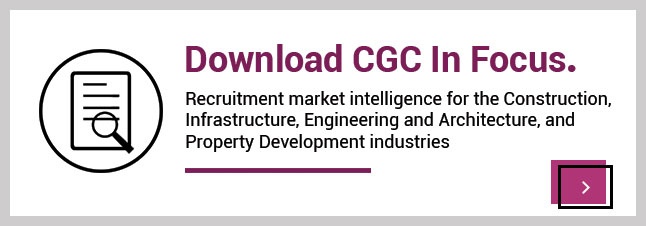In the third of our MarketWrap series, we take an overview of the Australia’s Engineering and Architecture marketplace over the past financial year and look ahead to the coming year.
Our specialists, Sydney-based Principal Consultant Martin Smallshaw, Christina Ryan, Senior Consultant, Architecture and Interior Design, and Matt Rayburn, Engineering Consultant in Brisbane, discuss growth areas, the key things for both clients and candidates to focus on, and the market forces and developments impacting Australia’s engineering and architecture sectors.
The State of the Market
Data Centres / Mission Critical is in short supply of talent, and this niche sector is the next big boom for Australia and APAC engineering and infrastructure.
Defence projects are performing strongly on the back of huge government investment, which is increasing year on year. The 2019–20 budget provided $38.7 billion for defence, equivalent to 1.9% of GDP.
In Queensland, roads and rail/transport engineering design have been busy due to the government’s push to build a better transport network. Companies are seeking to build teams of engineers and designers, who remain difficult to find to meet demand, which should continue if the same government remains in office.
Urban design and landscape architecture have been consistently busy in Sydney this year, with major infrastructure projects and the planning for future expansion of satellite cities fuelling this growth.
The skill shortage in Australia is very apparent in building services this year. Alongside this, fuelled by the collapse of the retail sector, building services have underperformed, with no bounce-back ahead, even before the damaging impact of COVID-19.

NSW Activity
Mission Critical continues to grow strongly on the back of increasing worldwide demand from the private sector and government for safe and secure centralised data stored in the cloud.
Opportunities are vast with both consultancy and client-side growth, with a knock-off effect for recruitment as there is a serious shortage of mission-critical experience. This makes it harder to directly attract qualified applications, so there is an increasing need to work with a recruitment agency.
In the Defence sector, the security and safety of Australia’s population is paramount, so government investment continues to be strong. Principal Consultant Martin Smallshaw sees the otherwise-quiet South Australian market continues to be impacted positively by the boost in defence budgets.
“Opportunities are concentrated within certain consultancies who have staff who possess the right security clearances. With the challenges and vetting involved, these take time and are not easy to obtain, but they are mandatory for any work carried out on a defence site.”
In the busy urban design and Landscape architecture sector, after a volatile market at the beginning of the financial year, 2020 brought good news as many projects were released, notably an increase in multi-residential, aged care and community projects.
The challenge at present is mainly the quantity of candidates that have worked at senior levels on specific projects. One example is the need for experienced landscape architects for major highway/ transport projects, with not many private-sector candidates being able to offer such large-scale infrastructure experience. An additional factor is that a lot of clients don't see the value in upskilling international candidates who are already in Australia.
The year’s challenges included many redundancies, with some quality candidates out of work for months. This resulted in an increase in contract opportunities, with companies not ready to commit to permanent staff in case projects fall through. However, some 70% of these contract placements resulted in a permanent position within just three months, so offer a good path forward.
Residential is underperforming due to oversupply, and of course, some prospective homebuyers may delay purchasing property during challenging economic times, when job security is uncertain and securing finance is more difficult. The current COVID-19 pandemic has, however, caused one of Australia’s keenest property investor groups to drop off, with a pullback from big international investors.
In May 2020, realstate.com.au was suggesting, based on their data, that after years of increasing search activity,
“There has been recent talk about the return of Chinese buyers of residential apartments in Australia, and while that may be the case for select projects, broadly speaking, Chinese search activity is overwhelmingly down.”
Queensland Activity
Transport Engineering Design is busy and exceeding growth expectations, due to Queensland receiving its share of Federal government spending. Roads and rail have been particularly busy, reflecting the Federal Government’s transport network investment.
Roads and rail projects in progress include the 1,700km Inland Railway from Melbourne to Brisbane, which started construction in 2018 and will be Australia’s largest infrastructure project ever undertaken when completed in 2024/2025. The government-backed/PPP project will contribute up to $16 billion to the economy and generate 16,000 jobs nationally, benefiting Queensland. In June, Prime Minister Scott Morrison announced the latest phases of this project would be fast-tracked, in an effort to jump-start the Australian economy.
This and other projects have meant clients are seeking to build teams of hard-to-find engineers and designers to accomplish this work, said CGC Queensland’s Matt Rayburn, Engineering Consultant.
“On top of that, you’ve got resistance from Queensland design or engineering consultancies to employ NSW candidates because the drainage codes and standards for roads and highways are completely different.
“So, we have to try and move people around within the QLD market. For Building Services Design, it’s not the full gamut of design and retail as we know it nationally.”
Construction began in 2019 on the massive casino, resort and residential Queen's Wharf project being developed by the Destination Brisbane Consortium joint venture, which will cover 26 hectares of the inner city and will cost more than $3.6 billion.
Another transport project, the $5.4 billion Cross River Rail development, will create a 10.2 km train line linking Dutton Park to Bowen Hills, featuring a 5.9km twin tunnel underneath Brisbane’s CBD and river. Due for completion in 2024, the train line will carry 164,000 passengers daily, create four new underground stations and redevelop two above-ground stations.
On the building side, it has been a flat year with no significant investment or growth and very few big projects going up.
Looking ahead to FY2020/21
As with much of the construction and infrastructure sector, the new financial year will bring both challenges and opportunities for Engineering and Architecture practices. While the wider national post-COVID economic recovery pathway is not clear, what is clear is that the Australian Government sees large infrastructure projects as a way to jump-starting the economy.
Attracting the right candidates with experience, skills and, where needed, clearances and accreditations will continue to be a key challenge for Engineering and Architecture practices, especially in niche areas. This would likely drive a need to build relationships with recruitment providers.
At CGC, we understand the big recruitment issues, and this depth of insight can give both our clients and candidates confidence to make the right decisions.
To get a full breakdown of key construction recommendations plus CGC’s view on the year ahead, download our full CGC in Focus Report.
CGC in Focus - Infrastructure Opportunities
At CGC Recruitment, our team of experienced consultants specialise in all major infrastructure, engineering and construction sectors. We help clients throughout Australia deliver their projects by attracting the best candidates and talent.
FY20 was a difficult year for most businesses – with elections (state and federal), rising unemployment, the drought, record national bushfires and, of course, COVID-19. It was a medical, a financial and a leadership crisis, all in one. That’s why we developed CGC in Focus, as a response to the unprecedented business environment, demonstrating where we see recruitment challenges and opportunities for both our clients and candidates to achieve positive personal, professional and commercial outcomes.
To download CGC in Focus, or connect with CGC today and one of our experienced consultants will be happy to help.
Sources











